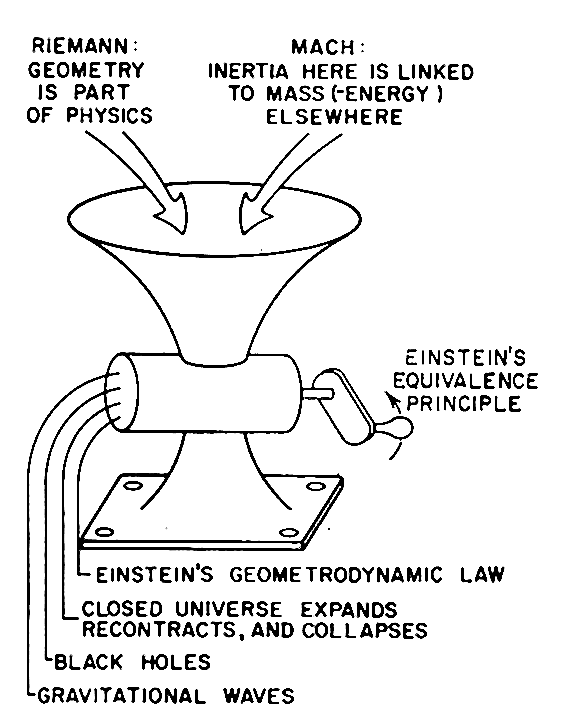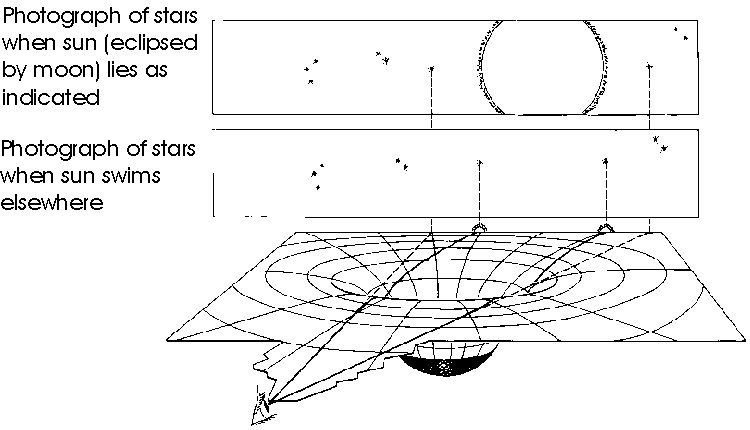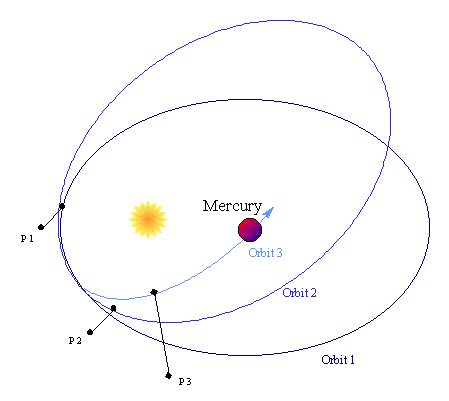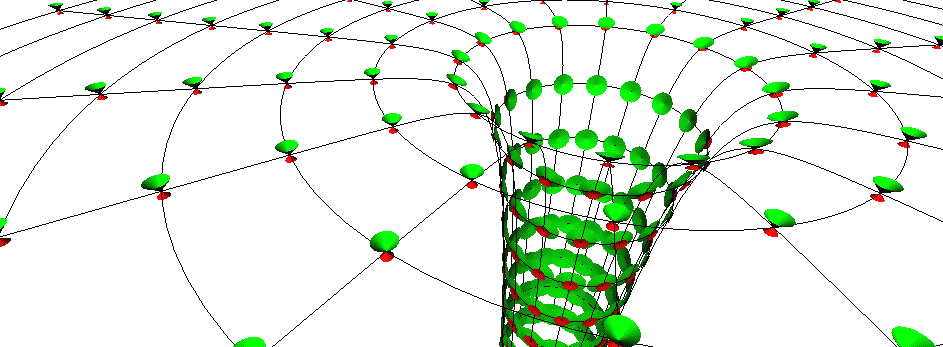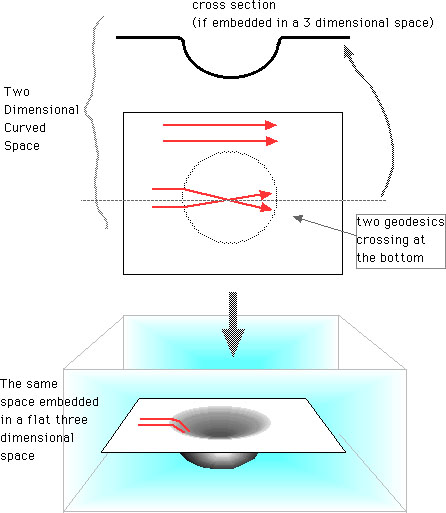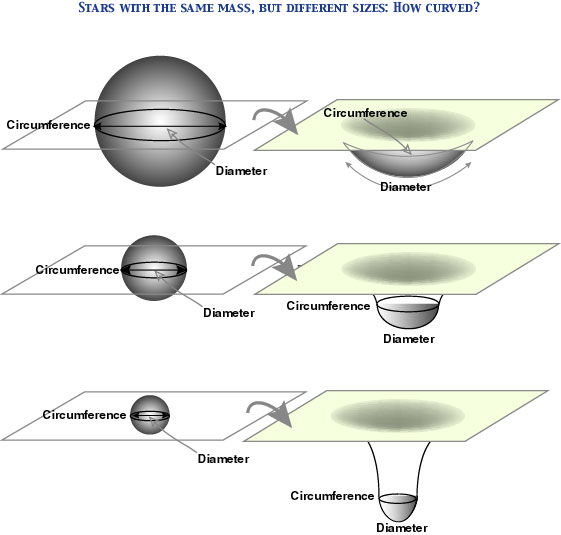Time Travel Research Center © 2005 Cetin BAL - GSM:+90 05366063183 - Turkey / Denizli
General Theory of Relativity
Einstein's Special Theory of Relativity of 1905 concerns itself with observers who are in uniform relative motion. His General Theory of Relativity of 1916 considers observers in any state of relative motion including acceleration. It will turn out that this will also be a theory of gravitation. This document introduces the General Theory of Relativity.
Three "Easy" Pieces
Einstein used three different pieces to built the General Theory of Relativity, which we describe here.
Piece 1 - Geometry is Physics
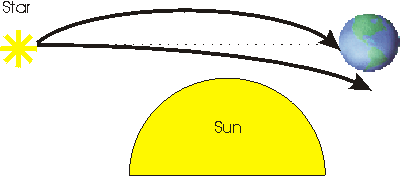
Consider the figure to the right, which shows a distant star, the Sun, and the Earth. Clearly the figure is not drawn to scale.
There is a straight dotted line connecting the star and the Earth.
Imagine a light ray that leaves the star along the dotted line: it is headed directly for the Earth.
However, we know that E = m c 2. And since the light that left the star has energy, we now know that it also has a mass. And all masses are attracted gravitationally by all other masses. So the light energy that left the star along the dotted line will be attracted gravitationally by the mass of the sun, which will cause its path to be deflected as shown. Thus that light ray from the star does not reach the Earth.
In fact, it is the upper trajectory in the figure that represents the light from the Star that reaches the Earth.
The simple definition of a straight line is that it is the shortest distance between two points. And we also know that light rays are the fastest way of getting information from, say, the star to the Earth. Thus, the upper path in the figure defines a straight line.
We imagine a flat plane as representing all three spatial dimensions plus the time dimension, a Flatland analogy. Then, we are now led to the view that the effect of a mass such as the Sun is to curve spacetime, which we represent by an "embedding diagram."
|
We say that a flat spacetime has a Euclidean geometry. Then the effect of a mass is to make the geometry around itself non-Euclidean. And in a gravitational interaction everything is moving in "straight lines" in this curved spacetime. Technical note: sometimes one uses the word geodesic instead of saying "straight lines.'
"So long as one believes that the universe is a big machine, it is natural to think that its various parts can exert a force on one another. But the deeper science probes toward reality, the more clearly it appears that the universe it not like a machine at all. So Einstein's Law of Gravitation contains nothing about force. It describes the behavior of objects in a gravitational field - the planets, for example - not in terms of `attraction' but simply in terms of the paths they follow." -- Lincoln Barnett, The Universe and Dr. Einstein, pg. 42
This view also seems consistent with a much earlier statement of Chinese philosophy:
"The inviolability of natural laws rest on [the] principle of movement along the lines of least resistance. These laws are not forces external to things, but represent the harmony of movement immanent in them." -- I Ching
It is also reminiscent of a graffiti: Gravity is a myth; the Earth sucks!
Piece 2 - Hiding the Universe in the Universe
| Consider two bodies that have electric charge Q and q. We know that because they carry electric charge, they exert forces on each other. We call the force electrostatic. |  |
| Now we consider two bodies that have masses M and m. Because they both have mass, in the Newtonian description we say that they exert forces on each other. We call the force gravitation. |  |
| Now we consider two bodies with masses M and m that are both moving to the right at the same speed relative to us. They both have inertia. Since they are travelling at the same speed, the body with the larger mass will have a larger inertia. |
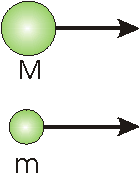 |
Above we have used the word mass in two different ways.
- We refer to the property of objects that causes them to interact gravitationally with other objects with this property. The magnitude of the gravitational interaction is proportional to the amount of gravitational mass the objects have.
- We refer to the property of objects that gives them inertia. The inertia of an object is the amount of its inertial mass times the speed it is moving relative to use. Thus a very massive ship moving at a small speed has considerable inertia, as does a light object moving at a high speed.
Note that although we use the word mass in both cases, there is no immediate and obvious reason why this inertial mass and gravitational mass should be related to each other.
We can compare the gravitational mass of two objects by weighing them, i.e. measuring their gravitational interaction with the Earth. We can also compare the inertial mass of same two objects by measuring their effects in collisions with other objects. These experiments have been done to great accuracy and precision, and the comparisons always come out the same. Thus we conclude that the gravitational and inertial mass are experimentally found to be the same for all objects.
This is different from comparing, say, the inertial mass of two objects with their electric charges. There is no relation between the two, and we can have an object with a large inertial mass but no electric charge and another object with the same inertial mass and a non-zero electric charge.
Einstein was the father of the theories of relativity, but Ernst Mach was the grandfather. Mach elevated and explained the equality of gravitational and inertial mass into what is now called Mach's Principle. As we shall see, although we will be able to achieve some understanding of this principle, a complete and unambiguous statement of it is difficult, maybe even impossible.
The principle of inertia says that every body will continue at rest or in uniform motion in a straight line unless forced to change that state of motion. And the Foucault pendulum is trying to obey that principle by rotating its plane of oscillation as the Earth turns under it. So this is a consequence of the inertial mass of the ball of the pendulum.
Here is what Mach said about the Foucault pendulum:
"The universe is not twice given, with an earth at rest and an earth in motion; but only once, with its relative motions alone determinable. It is accordingly, not permitted us to say how things would be if the earth did not rotate." -- The Science of Mechanics, T.J. McCormack, trans., pg. 266.
What he is suggesting is essentially that the property of inertia of the Foucault pendulum here is related to its gravitational interaction with the mass of the universe there.
Jay Orear stated the viewpoint of Mach's Principle nicely:
"The point of view taken here is that your head is the center of the universe and is always at rest. Whenever you bump your head against a wall, the distant galaxies have suddenly accelerated and exert a strong gravitational force on your head. In order to keep your heat 'at rest', the wall must exert an equal and opposite contact force. So the next time you bump your head or stub your toe, you can blame it on the distant galaxies." -- Fundamental Physics 2nd ed., pg. 288.
It is tempting to state Mach's Principle as follows:
In a universe with only one test mass, that mass would not obey the Principle of Inertia. At one moment it could be at rest, at the next moment it could abruptly be in motion.
The problem with this form is that it violates the basis of Mach's Principle, that the universe is only once given. Thus we can only talk about the universe we have, not some hypothetical non-existent one. It is probably this feature that makes a concise statement of the principle so difficult.
Here is another attempt to state the principle:
"Einstein gave the name Mach's Principle to the following related ideas:
- that only relative motion is observable and hence that there should be no dynamically privileged reference frames;
- that inertial forces should arise from a gravitational interaction between matter only, and so from an observer-dependent splitting of the total gravitational field;
- that spacetime is not an absolute element of physics but that its [geometry] is totally dependent on the matter content of the universe."
Reference: D.J. Raine, Monthly Notices, Roy. Astron. Soc. 171, (1975) pg. 507.
Incidentally, the title of this sub-section is from Chuang Tsu 6.
Piece 3 - The Equivalence Principle
Imagine that the room in which you are sitting is a cabin on a rocket ship. The cabin has no portholes so you can not look out. Devise an experiment to determine which of the following two situations are true:
- The rocket ship is sitting stationary on the surface of the Earth, where the acceleration due to gravity is 9.8 meters per second per second down.
- The rocket ship is in free space accelerating upward at 9.8 meters per second per second.
It turns out that for a reasonably small cabin on the rocket ship, no such experiment can be devised. Einstein elevated this to a general principle: "We shall therefore assume complete physical equivalence between the gravitational field and the corresponding acceleration of the reference system. (Reference: Jahrbuch der Radioaktivitat un Elektronik 4 (1908) pg. 443.) We call this Einstein's Equivalence Principle, which he later described as "the happiest thought of my life."
Einstein once stated the principle as:
"For an observer in free fall off the roof of his house, there exists for him during his fall no gravity."
At the very beginning of this document I stated that building a theory that considers observers in any state of relative motion, including relative acceleration, would also turn out to be a theory of gravitation. The Equivalence Principle is why this is true. A few years ago a student wrote a paper which had an appropriate typo: gravitivity.
Einstein's Synthesis
The following figure neatly summarises Einstein's achievement.
|
Some chronology may be interesting here. Einstein published the Special Theory of Relativity in 1905, based on 10 years of struggle with the question of what he would see if he pursued a beam of light at the speed of light. He thought of the Equivalence Principle a couple of years later, publishing it in 1908. He did not complete and publish the General Theory of Relativity until 1915, although he had been working hard on the problem since 1908. As he wrote to Sommerfeld in 1912:
"I am exclusively occupied with the problem of gravitation and hope with the help of a local mathematician friend [Marcel Grossman] to overcome all the difficulties. One thing is certain, however, that never in life have I been quite so tormented. A great respect for mathematics has been instilled within me, the subtler aspects of which, in my stupidity, I regarded until now as pure luxury."
The theory makes a number of predictions, which we will discuss.
Stellar Aberration
|

One of the first such confirmations, and Einstein's attitudes towards his theory, is provided in the following account by Ilse Rosenthal-Schneider:
"Einstein was discussing some problems with me in his study when he suddenly interrupted his explanation and handed me a cable from the windowsill with the words, `This may interest you.' It was the news from Eddington confirming the deviation of light rays near the sun that had been observed during the eclipse. I exclaimed enthusiastically, `How wonderful, this is almost what you calculated.' He was quite unperturbed.` I knew that the theory was correct. Did you doubt it?' When I said, `Of course not, but what would you have said if there had not been such a confirmation?' He retorted, `Then I would have to be sorry for dear God. The theory is correct'."
Reference: H. Woolf, ed., Some Strangeness in the Proportion (Addison-Wesley, 1980), pg. 523.
Expanding Universe
In 1915, when Einstein was finishing up his General Theory he realised that it predicted an expanding universe. However, the permanence of the universe was a fixed item of Western philosophy. This conflict between a dynamic non-permanent universe and the firm philosophical beliefs of the day bothered Einstein greatly. In fact, he weakened and modified his theory, introducing a cosmological constant, a fudge factor to make the universe static.
In 1929 Edwin Hubble was doing some interesting observational astronomy. It was known that there is a class of stars called Cepheid variables whose intensity varies periodically. Further there was a known relationship between the absolute brightness of a Cepheid variable star and the rate of the oscillation of its intensity. Thus by measuring the brightness of such a star on Earth we can calculate how far away the star is.
In addition, the spectrum of the light from a star when the star is at rest relative to us was also known. However, if the star is, say, moving away from us the Doppler effect will cause the wavelengths of the light to be shifted towards the red. You have probably noticed the Doppler effect when a car playing loud music goes by you: as it approaches the sound is shifted towards shorter wavelengths and as it recedes the sound is shifted towards longer wavelengths.
So by measuring the shift in the spectrum of light from a Cepheid variable we can determine its speed relative to us.
Here is a model that explains how such data can arise. We imagine that we are making raisin bread, but have misread the recipe and instead of putting in one teaspoon of baking powder we have put in one pound! As the dough starts to rise, it begins to fill our kitchen. If we stand on any given raisin, all the other raisins will be receding away from us; the further away the raisin is the faster it recedes away from us. Similarly, if the universe is expanding and the raisins represent the stars we will get the result observed by Hubble.
Here is a more accurate model. We imagine the universe as a Flatland confined to the surface of a balloon. Paint some dots on the balloon and think of them as the stars. Begin blowing up the balloon. If you stand on any dot and measure the position and speed of any other dot you will find that all the dots are receding away from you and their speed away from you increases the further away the dot is. Note that the dots are not moving on the surface of the balloon, rather the fabric of the balloon itself is expanding. Also remember that you must make your distance measurements staying within the surface of the balloon; the higher-dimensional direct connection from point to point via a chord inside the balloon is not accessible to us.
When Hubble published his results, Einstein immediately dropped the cosmological constant, calling it "the biggest mistake of my life."
Note that the Hubble data, as well as the two models we have used to think about it, indicate that at some time in the past the universe was very very small. In fact, current cosmology tends to favor a view that at some time on the order of 15 billion years ago the size of the universe was zero. At this time, the temperature was infinite, and the Big Bang occurred, initiating this cycle of the universe.
Gravitational Time Dilation
Just as moving clocks run slow, General Relativity predicts that clocks in gravitational fields run slow. This prediction of the theory has been confirmed many times.
Gravitational Length Contraction
Lengths of objects in gravitational fields are contracted according to the theory. The prediction has never been tested. For the keen, you may wish to derive this prediction using the same techniques used in the previous sub-section to derive gravitational time dilation.
Gravity Waves
Just as an oscillating electric charge generates an electromagnetic wave, General Relativity predicts that an oscillating mass will generate a gravity wave. Many attempts have been made to detect the existence of gravity waves, with results that are ambiguous at best.
There are currently some experiments that are being designed to attempt to detect these waves. One large project is the Laser Interferometer Gravitational-Wave Observatory (LIGO).
Advance of the Perihelion
|
Curvature and lightcones.
In this section I will look at the curvature and the lightcones in the vicinity of Black Holes.
Curvature:
How is the space curved around a Black Hole?
The curvature of a Schwarzschild Black Hole is a simple function of r because of spherically symmetry:
![]()
To prove it, you need to do a lot of tensor calculus.
Do you remember Einstein said something about: "Time is orthogonal to space..."? How can the time dimension be orthogonal to 3 space dimensions which are orthogonal themselves?
Most people know of the rubber sheet analogy where a sheet of
rubber is curved because of a heavy bowlingball, but the curvature of a
Black Hole is going to infinity for
![]() , where
all the mass is located in the singularity. We can still use this 2D
analogy to show the curvature of the equator plane of the Black
Hole. This process is also called embedding.
, where
all the mass is located in the singularity. We can still use this 2D
analogy to show the curvature of the equator plane of the Black
Hole. This process is also called embedding.
[The curvature of a 2D slice of a spherically symmetric Black Hole]
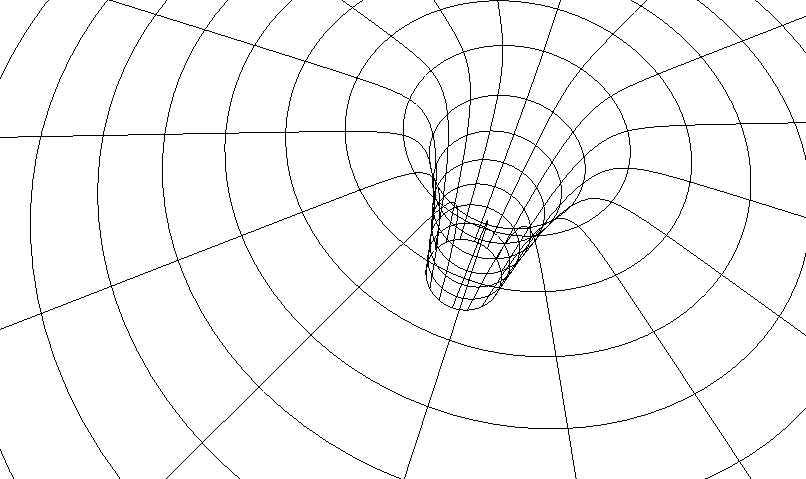
Lightcones:
If time is orthogonal to space, we can put small time-arrows in each grid point of the 2D space surface. These arrows point into the next layer of space in the "sandwich" of spacetime. It's even better to put lightcones in each grid point according to the curvature:
[Curved equator plane with lightcones. The green lightcones
represents the
future and the red lightcones represent the past (only shown half
size).]
Somewhere the distance from one slice to the next is smaller than
elsewhere. This is an effect of curvature. It is shown by the
contraction of the height of the cones far down the drain. The
proper time goes to zero. In the same time, the size of the cones
becomes bigger because the proper distance grows near the center. We
have these relationships between the proper time
![]() and dt
and between the proper distance dx and dr:
and dt
and between the proper distance dx and dr:
![]()
The lightcones get larger in the space coordinate and smaller in the time coordinate near the horizon.
Black Holes
When a gravitational field, a curvature in spacetime, becomes sufficiently intense, the theory predicts that the matter causing the field can be literally crushed out of existence. The curvature becomes so intense that a hole is punched in the fabric of spacetime. This phenomenon is called a black hole.
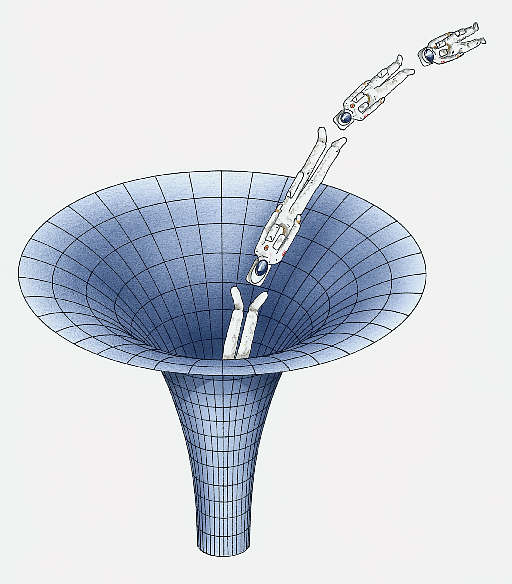
There are many observations that strongly suggest the existence of black holes that were formed when a star exhausted its nuclear fuel.
Embedding Diagram of a Black Hole

Embedding Diagram

Proper length.
We can visualize the curved geometry of spacetime by making measurements on a cross section of space though the equatorial plane of a star. WE make measurements in this real physical space and then construct a model that coveys the results of these measurements. Such a model is called an embedding diagram.
The embedding diagram is drawn so that the distance along the sheet (the proper length) corresponds to distance as measure in physical space. Because the ring separation is larger than what the Euclidean result, the embedding diagram is stretched. This stretching in the diagram is NOT the third dimension in physical space. It is merely a trick to help us visualize the curvature of a two-dimensional sheet.
Physicists can speculate about embedding physical three dimensional space in a higher dimensional flat hyperspace. However, such a hyperspace requires six spatial dimensions.
Comparison for physical space and hyperspace from Black Holes and
Time Warps by Kip S. thorne.
Embedding Diagram
It is hard for us to visualize a curved space or spacetime, especially if that space (spacetime) has three or more dimensions. However, physicists have invented a "trick" for visualizing a curved two-dimensional surface within an imaginary, flat, three-dimensional space, and that trick is called an "embedding diagram" (Misner et al 1973, 613ff; Thorn 1994, 129ff. 邦訳1997, 112ff.). You already know the distinction of intrinsic and extrinsic curvature. For instance, the surface of a sphere is a curved two-dimensional surface, and its curvature can be identified by measurements within that surface; thus we can say that the surface has an intrinsic curvature. However, we can of course visualize it within a three-dimensional space, by regarding it as the surface of a sphere in a flat, three-dimensional Euclidean space. The embedding diagram utilizes this relation. But do not imagine a higher dimensional space used for embedding as something "real"; it is only a fiction for enabling us to visualize the curvature.
Suppose a simple two-dimensional space, which has a concavity in the middle, as in the figure. Gravity in general relativity is expressed by the curvature of spacetime. This means that light rays, or free particles go along a geodesic, a straightest line allowed by the curvature. Thus if two light rays (red lines) come to the concavity, they will cross at the bottom (because of the curvature of this part), and this can be expressed by a two-dimensional figure. However, the image is somehow poor, and a better visualization is to embed this space into a three-dimensional Euclidean space, and express its curvature as an extrinsic curvature of a two-dimensional surface within this 3-space. The result is an embedding diagram.
The same trick can be applied to any two-dimensional surface in a curved 3-space or 4-space (spacetime). For instance, the equatorial plane crossing a star (spherical, without spin, and with a constant density) is a curved 2-space, and its embedding diagram is obtained as follows. For the sake of comparison, we consider stars with the same mass but with different sizes; you can see (intuitively) how the curvature of the equatorial plane (2-space) changes. On the left-hand side are pictures of physical (3-) space, and on the right-hand side are embedding diagrams of the equatorial plane (2-space). These embedding diagrams illustrate Schwarzshild's solution to the Einstein field equations. Such a diagram can be extended to a black hole too.
[The figure adapted from Thorn (1994), Fig. 3.4 on page 132.]
References
Misner, C. W., Thorne, K. S., and Wheeler, J. A. (1973) Gravitation, Freeman, 1973.
Thorn, Kip S. (1994) Black Holes and Time Warps, Papermac, 1995. [邦訳1997]
Hiçbir yazı/ resim izinsiz olarak kullanılamaz!! Telif hakları uyarınca bu bir suçtur..! Tüm hakları Çetin BAL' a aittir. Kaynak gösterilmek şartıyla siteden alıntı yapılabilir.
The Time Machine Project © 2005 Cetin BAL - GSM:+90 05366063183 -Turkiye/Denizli
Ana Sayfa /
index /Roket bilimi /![]() E-Mail /CetinBAL/Quantum Teleportation-2
E-Mail /CetinBAL/Quantum Teleportation-2
Time Travel Technology /Ziyaretçi Defteri /UFO Technology/Duyuru
